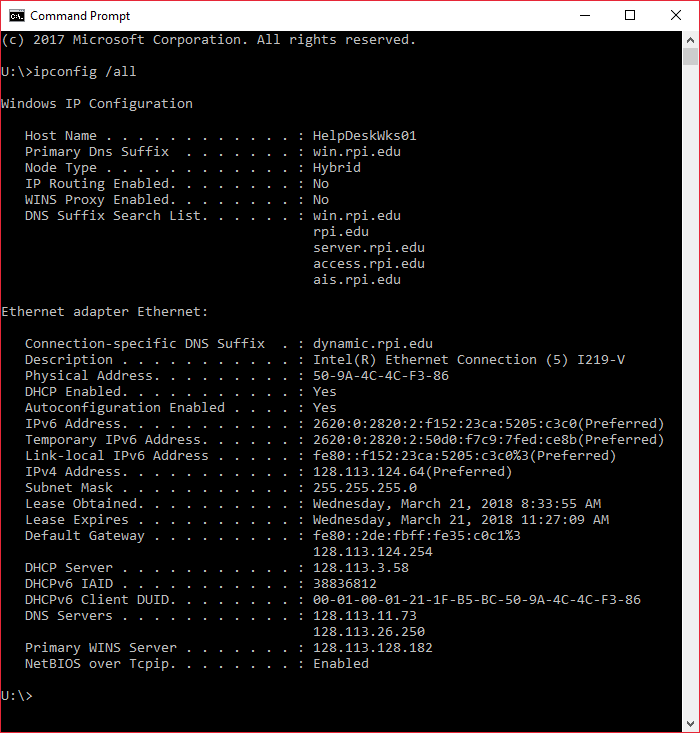
- #CHECKING IP ADDRESS ON MAC OS X HOW TO#
- #CHECKING IP ADDRESS ON MAC OS X MAC OS X#
- #CHECKING IP ADDRESS ON MAC OS X SERIAL#
#CHECKING IP ADDRESS ON MAC OS X SERIAL#
If this doesn't work, you may need a USB/Serial converter and suitable cable to access the serial port if you need to change settings on the switch. In the space provided below the option Enter the network address to ping, enter the IP address or web URL for which you want to set the. Choose Network Utilities and now, click on Ping.
#CHECKING IP ADDRESS ON MAC OS X HOW TO#
If you are able to determine the IP address, in order to talk to it you'll have to configure your Mac with an IP address in the same network in order to 'talk' to it. How to Test Ping on your Mac with Network Utility.

If it's IP traffic, you'll see the IP address. Any traffic originating at the switch should be visible in tcpdump. If it does DHCP or even some other protocols, this should trigger it to do a request.ģ. Power the switch down, wait a tick, then power it back up. Better still, just have it dump all traffic regardless and unplug your other computers to cut the noise.Ģ. Start tcpdump with the options to show all traffic to/from the MAC address of your switch. You'll have to 'sudo -s' to root in order to use it, I expect. Get into OS X terminal and read up on 'man tcpdump'. However, from what you say, having inherited the switch suggests that you're not going to succeed with this approach. I just go, 'ping 10.0.1.255' and watch the replies come in. You just have match the MAC address of you NA, which will be printed on it and look for IP in. It will show all the device that are attached to your network with IP addresses and MAC addresses. One ping on my broadcast address returns at this time two replies from both other IP hosts on my network in about 6 milliseconds. First, Open the terminal window and use ARP (Address Resolution Protocol) tool to find-out all the network attached devices.

If it has an IP stack and isn't real old, it probably does DHCP, so checking the server log for that MAC address should work. Some early devices initialized to some default IP address, and if you didn't want to use the serial port, you had to plug a computer to the switch and configure it on a 'private network' (same as the switch's default) to configure it with an IP address on your network. If your switch does NOT have an IP address on your network, none of this has much meaning.Ĭheck the docs on your switch to see what they say.
#CHECKING IP ADDRESS ON MAC OS X MAC OS X#
Your broadcast address is shown in the Mac OS X terminal with 'ifconfig -a'. My network, for example, is 10.0.1.0 with broadcast address 10.0.1.255, and I can see multiple hosts with a broadcast ping ('ping 10.0.1.255') from OS X. Ping it and it will put an entry in the ARP table you can check with 'arp -a'. You wouldn't see the MAC address, but look for an IP you didn't know about. If the switch has an address that's on your network, you could see it in the replies. If your network has a DHCP server, and the switch uses DHCP to configure its IP address, you should see its IP assignment in the DHCP log on the server.Īnother approach might be to do a ping from your OS X terminal to the broadcast address for your network. But, if the switch has an IP address on your network, and does any talking on your network, an 'arp -a' in the terminal will show you all the MAC/IP address pairs OS X knows about, so you might find it there. What you're asking to do is 'reverse ARP', but I don't see it (rarp) in OS X. If your Linux OS does not have the ifconfig command, you may also use the ip addr command.First, your switch doesn't necessarily have an IP address, or at least not one that you could access from your own IP address (it might not be in your network). The MAC address will be listed next to HWaddr. The result will include the IP address of the printer. For example, ZSR-207-XRX will need to be entered as nslookup. Linux Open a terminal and use the ifconfig command. Enter the command ' nslookup ' and the printers network name in the field below - you will need to add.




 0 kommentar(er)
0 kommentar(er)
